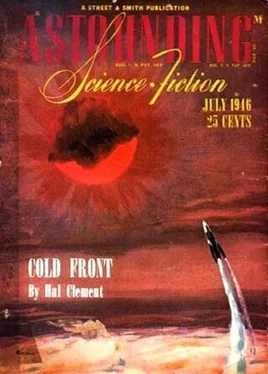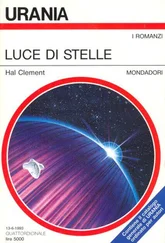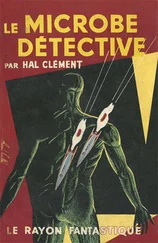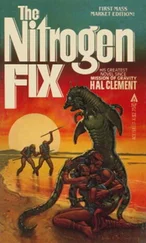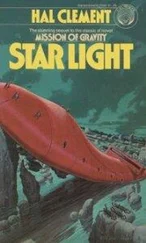Hal Clement - Cold Front
Здесь есть возможность читать онлайн «Hal Clement - Cold Front» весь текст электронной книги совершенно бесплатно (целиком полную версию без сокращений). В некоторых случаях можно слушать аудио, скачать через торрент в формате fb2 и присутствует краткое содержание. Год выпуска: 1946, Издательство: ASTOUNDING Science Fiction: July 1946, Жанр: Фантастика и фэнтези, на английском языке. Описание произведения, (предисловие) а так же отзывы посетителей доступны на портале библиотеки ЛибКат.
- Название:Cold Front
- Автор:
- Издательство:ASTOUNDING Science Fiction: July 1946
- Жанр:
- Год:1946
- ISBN:нет данных
- Рейтинг книги:4 / 5. Голосов: 1
-
Избранное:Добавить в избранное
- Отзывы:
-
Ваша оценка:
- 80
- 1
- 2
- 3
- 4
- 5
Cold Front: краткое содержание, описание и аннотация
Предлагаем к чтению аннотацию, описание, краткое содержание или предисловие (зависит от того, что написал сам автор книги «Cold Front»). Если вы не нашли необходимую информацию о книге — напишите в комментариях, мы постараемся отыскать её.
(short story,
July 1946).
Cold Front — читать онлайн бесплатно полную книгу (весь текст) целиком
Ниже представлен текст книги, разбитый по страницам. Система сохранения места последней прочитанной страницы, позволяет с удобством читать онлайн бесплатно книгу «Cold Front», без необходимости каждый раз заново искать на чём Вы остановились. Поставьте закладку, и сможете в любой момент перейти на страницу, на которой закончили чтение.
Интервал:
Закладка:
“How about night cooling?” asked Vickers. “This planet rotates more slowly than Earth.”
“Not enough; in summer the nights are short anyway; and why would it wait until now, fully two Earth years after midsummer, to take effect?”
“Then how about this mist that seems to have been cutting off some of the sunlight of the last day or two? You must have noticed it — it appears to be above any level at which we’ve flown, so it can’t be very dense; but it seems to be practically planet-wide, and cuts off enough light for me to notice without instruments.”
“I hadn’t noticed it particularly,” said Rodin thoughtfully. “A high layer of water vapor or dust would have a blanketing effect, and would actually increase surface temperature, even though it cut off some visible light. However, there’s something to the idea; the stuff might just possibly have a high reflecting power, I suppose. It won’t hurt us to go up and find this layer, anyway.”
Rodin went back to the controls, and started the ship climbing slowly. Then he started the recorder of the radiograph he had set up at one of the portholes when he had first arrived, and waited while they rose through the thinning atmosphere to a level at which the outside pressure was no longer detectable. There he stopped ship and recorder, and removed the graph from the latter. The haze layer, if it existed, should have betrayed its presence by a more or less sharp break in the curve — or rather, a change in its slope — at the proper level; but Rodin, to his disgust, was unable to find anything of the sort by visual inspection. He was beginning to check the instrument for flaws that would affect its sensitivity, when Vickers remarked that the sun seemed still to be rather weaker than usual — rather as Sol would appear from Earth during a partial eclipse, allowing for the difference in their intrinsic luminosities.
“An eclipse?” queried Rodin. “Hekla has only two satellites big enough and near enough to produce a respectable eclipse; and even the partial phase would last only a few hours. You noticed this dimness a couple of days ago.”
He went to the port and looked up at the sun. From Hekla’s surface the human eye could bear to look directly at R Coronae’s immense disk, but here above the atmosphere it was a little too bright for comfort. He rummaged in a drawer under the control panel, found a pair of shielded goggles; with these he approached the port again, and looked long and earnestly at the fuzzy crimson blot hanging in the blackness of space. At last he called Vickers, gave him the goggles, and asked him to look, describe, and if possible explain what he saw. Vickers obediently donned the eye shields and went to the port.
He had seen red giant suns before — who hadn’t? He was familiar with the brilliant crimson or orange disks, with brightness fading rapidly toward the ill-defined edges, bordered by a faintly luminous rim of atmosphere that faded rapidly outward against the star-shot background of the Galaxy. R Coronae should have been the same.
Perhaps it was, he thought at last. Perhaps it did have a normal disk; but he couldn’t see it — at least, not all of it. The lower quarter was visible, fading as it should and equipped with a normal atmosphere rim. A short distance up from this lower edge, however, a black line was etched across the crimson, projecting on each side. Where it appeared against the background of space, it glowed very faintly red. Above the line the stellar disk was hidden almost completely, as though by a cloud whose edge was represented by the border of black. The cloud, if it was a cloud, apparently grew thinner toward the top; for the upper side of the disk was faintly visible through it. Vickers slid the goggles up on his forehead and took a quick look at the sun without them. He could see the foggy disk, and was just able to make out the dark line. Evidently the “cloud” actually cut off less light than the view through the shields indicated; but if, as it appeared, the appendage were attached to the star rather than to Hekla itself, a drop in temperature was not very surprising. He turned away from the port and addressed Rodin, who was waiting impatiently.
“If clouds are possible in a star’s atmosphere, I’d say you had something on R Coronae quite similar to this cold front of yours right below us,” he said. “If it happens very often, I suppose it’s the explanation of the star’s variability.” He made this statement, so staggering to the meteorologist, in such a matter-of-fact tone that it was several seconds before Rodin could find voice. Finally he half-spoke, half-choked:
“You…you mean you have known all along that this star is a variable, and didn’t think it worth while to tell me? You mean—” he sputtered, and lost voice again; and Vickers realized that the color of his face was not entirely due to the sunlight.
“Of course I knew it was a variable; didn’t you? Most of the red giants are, to a slight extent, but it doesn’t particularly bother the planets of Betelgeuse and Antares. I remembered that, and looked up this star in the type index before we arrived. It gave a C.I. and size about the same as the giants I mentioned, and was marked ‘V’ as they were, so I supposed it was the same sort of business here.”
Rodin did not answer, but turned on his heel and strode back to the library, Vickers close behind. He found the index Vickers had used, checked its source of information, and located the indicated volume on the shelves. He thumbed through this for a moment, stopped, and read silently for a minute or two; then he handed the tome to Vickers and indicated the proper section. Vickers read, and slowly understood.
“—a Coronae Borealis is the name-star of a group of suns characterized photometrically by a light-curve of the form shown, and spectroscopically by the presence of strong carbon indications. It was suggested long before interstellar travel was achieved that the light variations were caused by temporary condensations of carbon vapor in the stellar atmospheres; and the correctness of this assumption was shown in the excellent series of photographs made by the Galactic Survey ship Zenith, which follow the formation of masses of carbon clouds through a full cycle from the beginning of condensation to complete dispersal. The actual mechanism and processes involved have not been closely studied, but it has been suggested that such a study should be conducted by a composite board of astrophysicists and meteorologists, as the phenomena seem to bear strong resemblance to those of planetary weather.
“ ‘The Zenith noted the presence of two planets in a cursory photographic sweep of the R Coronae system, but they were not closely examined, nor was the possibility of the presence of others eliminated.’ “
Rodin nodded slowly as Vickers finished his reading.
“You called the shot very nicely a few minutes ago,” he said, “when you called that black line a cold front. I should say that you were one hundred percent right. Blast it, to be a meteorologist in this system I’d have to know more astrophysics than a lot of Federation professors. You’ve certainly let me make an awful idiot of myself in front of those Heklans.”
“Do you really think so?” asked Vickers seriously. “I don’t see how they could expect you to know any better. You’re a meteorologist, not an astronomer, as you said.”
“On this planet, the distinction is probably narrow to the point of invisibility. Their weather men would have to be first-rate solar physicists. I must have seemed to them like a self-opinionated, bungling incompetent — insisting time after time on the feasibility of a plan whose greatest flaw would have been obvious to a Heklan layman. I don’t want to go back to that station, Alf — I couldn’t face one of those people now.”
Читать дальшеИнтервал:
Закладка:
Похожие книги на «Cold Front»
Представляем Вашему вниманию похожие книги на «Cold Front» списком для выбора. Мы отобрали схожую по названию и смыслу литературу в надежде предоставить читателям больше вариантов отыскать новые, интересные, ещё непрочитанные произведения.
Обсуждение, отзывы о книге «Cold Front» и просто собственные мнения читателей. Оставьте ваши комментарии, напишите, что Вы думаете о произведении, его смысле или главных героях. Укажите что конкретно понравилось, а что нет, и почему Вы так считаете.
